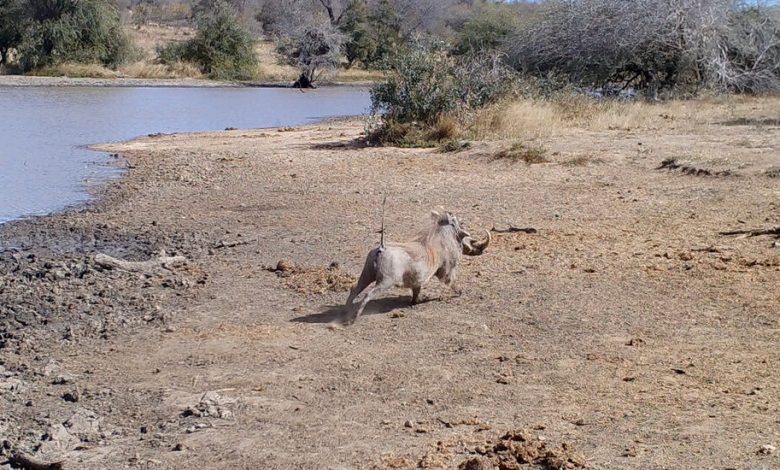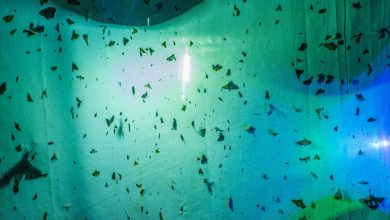Video Recordings Reveal the Scariest Sound on the Savanna

Panting after chasing the impala now in its jaws, a leopard drags its prey to a shady spot beside a water hole. Before it can sit down to feast, a voice, seemingly out of nowhere, begins speaking calmly. “It is very difficult to talk in Afrikaans …,” begins the bodiless voice. The leopard pauses, glances toward the source of the sound and then drops its hard-earned quarry and runs.
This leopard has unwittingly abandoned its lunch in the service of science. Researchers analyzed thousands of video recordings to reveal a hierarchy of fear in a suite of mammals living in and around Kruger National Park in South Africa. While lions have been nicknamed the king of beasts, the videos show that for wild mammals on the savanna — from tiny antelopes to massive elephants — the scariest, most lethal predator of all is us.
The sound of human voices, the researchers found, evokes more fear than the sounds of snarling and growling lions. This underlines that our species is recognized as uniquely dangerous, “because we are super lethal,” said Michael Clinchy, a conservation biologist at Western University in London, Ontario.
The researchers hope that understanding this universal fear of humans could assist the goal of preventing wildlife poaching.
The study the videos are drawn from, published Thursday in the journal Current Biology, is the latest in a series by Liana Zanette, also of Western University, and Dr. Clinchy, whose team studies fear. Dr. Zanette, Dr. Clinchy and their colleagues have shown that it’s not just being eaten, but fear of being eaten that creates profound effects rippling from individuals to whole communities. So turning to the savannas of South Africa, where a diversity of mammals have evolved for millenniums alongside lions and human hunters, Dr. Zanette and Dr. Clinchy were curious: Where did humans rank on the scale of scariness among these mammals?
Working with local colleagues from South Africa and other collaborators, the researchers set up equipment that has tested the fear responses of various animals. The motion-triggered automated behavioral response systems record video of passing mammals as they respond to a mix of sounds on a spectrum from potentially scary to harmless.
The researchers attached recorders and audio speakers to trees near 21 water holes, habitats that thirsty animals are reluctant to leave during the dry season, when the research took place. The devices ran 24 hours a day for six weeks, playing clips of sound types in random order when triggered by movement.
The benign sounds — the control in the experiment — were the songs of local birds. The more threatening sounds were dogs barking, gunshots, lions snarling and growling and humans talking calmly.

Liana Zanette, of Western University, with the experimental setup affixed to a tree, the camera trap in her left hand and the speaker playing lion noises above it.Credit…Clinchy et al., Current Biology
The human voices included women and men speaking in Tsonga, Northern Sotho, Afrikaans and English, gleaned from selected South African news clips — with a smattering of soccer, of course, in case mammals were short on sport.
The researchers paid close attention to equalizing the volumes for all sound types, so that any potential scariness was a result of content, rather than loudness. To achieve this, they used the sounds of lion snarls and growls instead of their much louder roars.
The team chose running away as a behavioral measure that was common and easy to measure. Each video was scored for speed at which an individual animal ran and the time it took to abandon the water hole.
Analyzing more than 4,000 videos, focusing on 19 species, revealed that when confronted with humans talking, animals were twice as likely to run and would abandon water holes 40 percent faster than when they heard lions, dogs or guns.
The contrast in flight response to human voices and lion snarls and growls was pronounced in most species, including giraffes, leopards, hyenas, zebras, kudus, warthogs and impalas.
Like the other mammals on the savanna, elephants fled when they heard human voices.
“They just high-tail it out of there,” Dr. Clinchy said.
But when it came to their response to lion sounds, the elephants were a notable exception. Instead of fleeing, elephants ran toward the source of the sounds, in some cases smashing into the devices violently.
“The elephants gave us a lot of headaches,” Dr. Clinchy said. In one video, recorded at night during a lion playback, an elephant smashes the recorder, the camera goes black, and elephants trumpet as they leave.
Aggressive reactions by elephants to lions are well known, said Karen McComb, a University of Sussex animal communication researcher whose team did acoustic experiments on elephants in Kenya. Hearing lion sounds, she explained, elephants often bunch together, defending babies and advancing toward audio recordings of lions.
“They never did this to our playbacks of human voices,” Dr. McComb said. “Elephants are large enough to be able to mob and drive lions off,” she added, but against humans armed with spears or guns, approaching could be fatal.
In the new study, researchers were intrigued by the responses of rhinoceroses. Rhinos fled human voices twice as fast as they did lion sounds. And during the period of the research, five highly endangered Southern white rhinoceroses were poached from nearby reserves. So one of the applications the team wants to explore in future research, Dr. Clinchy said, is whether using human voice playbacks could keep animals away from fence lines near roads, where a lot of poaching happens.
Chris Darimont, an ecologist at the University of Victoria in British Columbia who was not involved in the study but reviewed the paper for the journal, praised it while noting that its focus on sounds was a limitation. He hoped future research would incorporate olfactory cues.
“We might expect to find even more stunning impacts of humans given the nature of smell, the enormous sensitivity of smell by mammals, and the ways by which smells can linger,” Dr. Darimont said.
Ishana Shukla of the University of California, Davis, who is studying mammal responses to human disturbances, complimented the study’s breadth. By looking at the reaction to human disturbances in the whole mammal community, she said, “we can get a bigger picture of what’s actually happening to the system, instead of just one moving part.”
As for the lions of Kruger, they appeared unmoved by the human interlopers using their snarls for science.
Once, departing by truck after two hours assembling and elephant-proofing a recorder, Dr. Clinchy and Dr. Zanette realized that lions had secretly been making their own field observations of them.
“This female lion from across the water hole stood up from the grass and walked away,” Dr. Zanette said. “She was there the whole time!”



